

Latest Update: As per the latest report published by the Civil Aviation Authority of Nepal (CAAN) for the year 2024, Tenzing Hillary Airport in Lukla has made significant advancements to enhance security. A new baggage screening X-ray machine has been installed, ensuring smoother check-ins and improved safety for travelers heading to the Everest region.
Lukla Airport, also known as Tenzing-Hillary Airport, is the primary entry point for trekkers and climbers heading to Mount Everest and the Everest Base Camp (EBC).
Located in the Khumbu Region of Nepal, this small airstrip sits at an elevation of 2,845 meters (9,334 feet), which makes it one of the highest airports in the world.
Lukla Airport is renowned for its extremely short runway (527 meters, 1,729 feet). The runway has a 12% gradient, so planes must land uphill and take off downhill to compensate for the steep slope.
The airport operated 69868, 53009, 25718 and 5270 flights in 2023, 2022, 2021 and 2020, respectively (Civil Aviation Authority of Nepal, 2024).
Lukla is the starting point for a majority of Everest treks, including ones to Everest Base Camp, Gokyo Lakes, Mera Peak, Lobuche Peak, and the High Passes Trek.
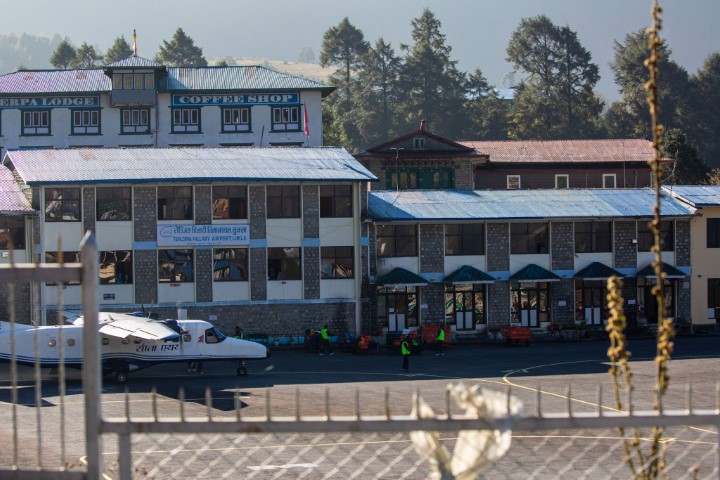
Before the airport was built in 1964, reaching the Khumbu Valley required a week-long trek from Jiri. Today, the 30-minute flight from Kathmandu saves trekkers days of exhausting hiking. The airport has made Everest expeditions far more accessible.
It also supports the local Sherpa economy, transporting supplies, medical evacuations, and tourists who sustain the region’s lodges and guiding services.
Key Facts About Lukla Airport
| Category | Details |
| Official Name | Tenzing-Hillary Airport (renamed in 2008 to honor Sir Edmund Hillary and Tenzing Norgay, the first climbers to summit Everest) |
| Location | Lukla, Solukhumbu District, Nepal |
| Altitude | 2,845m (9,334ft) High enough to cause mild altitude sickness upon arrival |
| Runway Length | 527m (1,729ft) One of the shortest commercial runways globally |
| Runway Slope | 12% incline helps slow planes on landing and provides extra lift on takeoff |
| Airlines | Tara Air, Summit Air, Sita Air |
| Flight Duration | 25 to 40 minutes from Kathmandu |
Lukla Airport is known as a dangerous airport due to a combination of extreme environmental factors and operational challenges. However, it isn’t as scary as these sensationalised headlines make it out to be.
While it is true that, unlike conventional airports, Lukla’s location in the Himalayas forces pilots to navigate a short, sloping runway surrounded by steep terrain and unpredictable weather, accidents at the airport aren’t a common occurrence at all.
The airport’s high altitude means thinner air, which reduces aircraft lift and engine performance. This, combined with a runway just 527 meters (1,729 feet) long, leaves minimal room for error during takeoff and landing.
Unlike most airports, Lukla has no go-around options if a pilot misses the approach; there’s no safe way to abort and try again due to the surrounding mountains.
Weather adds another layer of risk. Sudden fog, strong winds, and low visibility frequently disrupt flights, forcing cancellations with little warning. The airport operates only under Visual Flight Rules (VFR), meaning pilots must see the runway clearly to land, and no instrument guidance is available.
These factors need exceptional skill from pilots, who require specialized training before attempting Lukla’s challenging approach. Modern safety measures have improved reliability.
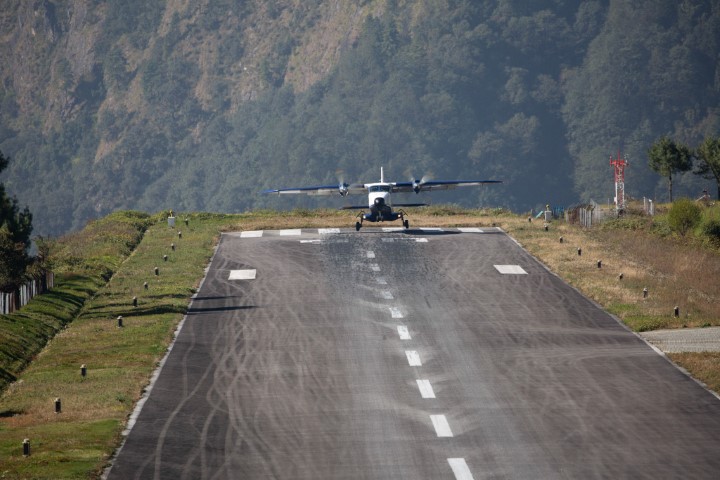
Several factors contribute to Lukla’s reputation as a dangerous airport. These include:
a) Short Runway: At just 527 meters, pilots must make precise landings with minimal margin for error.
b) High Altitude: Thin air reduces engine power and lift, making takeoffs and landings more difficult.
c) Unpredictable Weather: Sudden fog, wind, and cloud cover frequently cause delays or cancellations.
d) No Instrument Landing System (ILS): Pilots rely solely on visual flight rules (VFR), meaning clear visibility is mandatory.
e) Mountainous Terrain: The airport is nestled in a narrow valley, surrounded by peaks that create turbulence.
Lukla Airport was built in 1964 under the initiative of Sir Edmund Hillary, the New Zealand mountaineer who, along with Tenzing Norgay Sherpa, was the first to successfully summit Mount Everest in 1953.
Recognizing the need for improved access to the Khumbu region, Hillary initiated the project through the Himalayan Trust, a foundation he established to support Sherpa communities. This is why the airport is also known by the name ‘Tenzing Hillary Airport’.
The original airstrip was a basic dirt runway, built into the mountainside by local Sherpa laborers using simple tools. The land was purchased from local farmers for a reported $2,650, which, although not a substantial amount at the time, was a significant sum of money.
The airport’s primary purpose was to transport construction materials for schools and hospitals in the region, as well as to provide a faster route for mountaineering expeditions.
In its early years, Lukla served mainly small piston-engine aircraft like the Pilatus Porter, which could handle the short, unpaved runway. However, the airport’s high altitude, narrow valley location and unpredictable weather made operations a little risky.
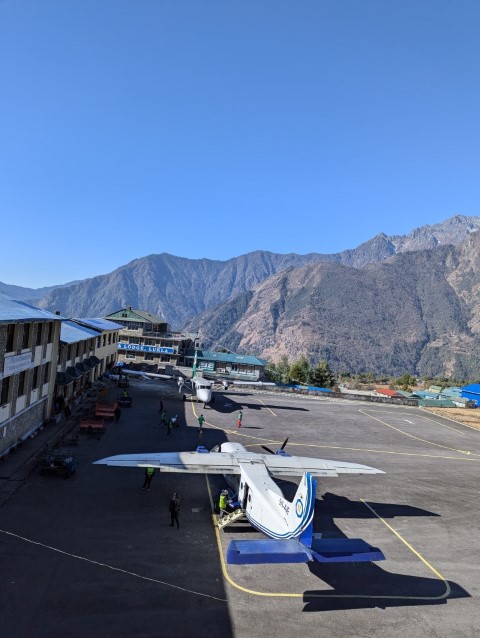
Pilots had to rely entirely on visual approaches, with no radar or instrument landing systems. The original runway was unpaved and prone to erosion.
In 2001, the runway was paved with asphalt, which improved its safety considerably and allowed for more reliable operations. The upgrade enabled larger aircraft, such as the DHC-6 Twin Otter and Dornier 228, to service the route.
In January 2008, the airport was officially renamed Tenzing-Hillary Airport in honor of the first Everest summiteers. The renaming recognizes Hillary’s role in its construction.
Today, Lukla handles about 50 daily flights during peak trekking seasons (spring and autumn), and is the starting point for most of Everest Base Camp treks.
It also supports emergency evacuations for injured trekkers and climbers, supplies transport for remote Sherpa villages, and helicopter operations for expeditions and rescue missions.
Major Historical Milestones
| Year | Event |
| 1953 | Sir Edmund Hillary and Tenzing Norgay summit Everest. |
| 1964 | Lukla Airport was constructed as a dirt airstrip. |
| 1971 | Officially opened for regular flights. |
| 2001 | Runway paved with asphalt. |
| 2008 | Renamed Tenzing-Hillary Airport. |
Despite its infamous reputation, Lukla Airport has a strong safety record due to strict regulations, advanced technology, and highly trained pilots. Despite its challenging geography, modern aviation standards and operational protocols ensure safe operations for the thousands of passengers who fly here annually.

Contrary to popular belief, major accidents at Lukla are rare. The airport has seen only a handful of incidents in its 60 plus years of operation, with big safety improvements implemented after each.
| Date | Aircraft | Operator | Details | Fatalities | Survivors |
| 15 Oct 1973 | DHC-6 Twin Otter 300 (9N-ABG) | Royal Nepal Airlines | Hard landing, damaged beyond repair | 0 | 6 (3 crew and 3 passengers) |
| 9 Jun 1991 | DHC-6 Twin Otter 300 (9N-ABA) | Nepal Airlines | Unstabilized approach in bad weather | 0 | 17 (3 crew and 14 passengers) |
| 26 Sep 1992 | Harbin Y-12-II (9N-ACI) | Royal Air Nepal | Takeoff failure | 0 | 14 (2 crew and 12 passengers) |
| 25 May 2004 | DHC-6 Twin Otter 300 (9N-AFD) | Yeti Airlines | Crashed into Lamjura Hill during approach | 3 (crew) | 0 |
| 1 Oct 2004 | Dornier 228 | Sita Air | Nose gear collapse on landing | 0 | All survived |
| 30 Jun 2005 | Dornier 228 | Gorkha Airlines | Skidded off runway | 0 | 12 (3 crew and 9 passengers) |
| 8 Oct 2008 | DHC-6 Twin Otter 300 (9N-AFE) | Yeti Airlines | Crashed on final approach in bad weather | 18 | 1 (captain) |
| 12 Oct 2010 | Dornier 228 (9N-AHB) | Sita Air | Braking failure, hit wall | 0 | All survived |
| 26 Sep 2013 | Helicopter (9N-AEX) | Air Dynasty | Rotor struck wall | 0 | 4 (all survived) |
| 27 May 2017 | Let L-410 (9N-AMH) | Summit Air | Crashed short of runway in poor visibility | 2 | 1 (injured) |
| 14 Apr 2019 | Let L-410 (9N-AMH) + Helicopter (9N-ALC) | Summit Air + Manang Air | Runway Collision during takeoff | 3 | 4 (injured) |
Note: (Bureau of Aircraft Accidents, 2025)
The Lukla Airport has only had 5 incidents in 23 years, with no crashes since 2019. Over 50,000 flights operated safely in the same period.
Only 20-30 pilots in Nepal are certified to fly to Lukla, all with Himalayan-specific expertise. Pilots flying to Lukla must meet Nepal’s strictest aviation requirements:
- 100+ Short Takeoff/Landing (STOL) flights in Nepal.
- 1 year of STOL experience minimum.
- 10 supervised Lukla landings with an instructor.
- Annual Simulator Training for high-altitude emergencies.
Lukla now integrates modern safety systems. Those are:
- Real-time weather monitoring: Automated stations provide live wind/fog data.
- Enhanced Runway Lighting: High-visibility strobes for low-cloud landings.
- GPS-aided navigation: Though VFR is primary, GPS helps track terrain.
- Weight sensors: Ensure aircraft aren’t overloaded, which is critical for thin-air performance.
- Morning-only flights: 6:00 AM–12:00 PM to avoid afternoon turbulence.
- Strict weight limits: 15kg baggage/passenger (weighed at check-in).
Recent Update: A recent report from the Civil Aviation Authority of Nepal (CAAN) for 2024 highlights an important development at Lukla Airport. To enhance security and streamline the check-in process for travelers, a new baggage screening X-ray machine has been installed at Tenzing Hillary Airport, Lukla.
This improvement is part of ongoing efforts to ensure safer and more efficient travel for those heading to Mount Everest, the highest peak in the world.

Myth: Lukla has monthly crashes.
Fact: 5 incidents in 23 years (0.2% of flights). Safer than Nepal’s highways.
Myth: The runway is too short to be safe.
Fact: The 12% slope actively aids braking/takeoff. STOL aircraft are designed for this.
Myth: Pilots gamble with the weather.
Fact: Flights cancel at the first sign of risk, no exceptions.
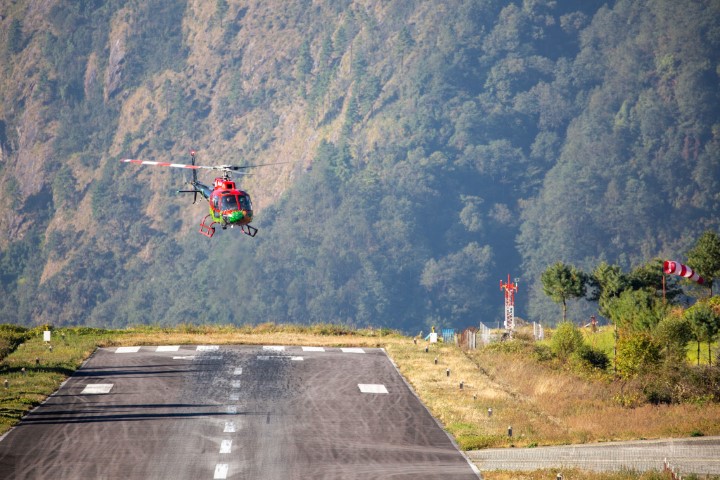
Morning departures (between 6:00-9:00 AM) offer the highest success rates for Lukla flights. Most cancellations occur after noon when Himalayan weather typically deteriorates. The cold, stable morning air provides better aircraft performance and visibility needed for flight.
The earlier you fly, the more rebooking options exist if delays occur, as later flights often face cascading cancellations throughout the day.
The 15kg total weight limit (10kg checked + 5kg carry-on) is strictly enforced due to critical aircraft performance requirements at high altitude. Seasoned travelers use military-style packing strategies, i.e., wearing all heavy clothing during weigh-in (boots, jackets, even stuffing pockets with gear), using ultra-compressible packing cubes, and sharing group equipment with trek mates.
Airlines will remove items from your bags at check-in if overweight. We have seen trekking poles, toiletries, and even medical kits get left behind.
Since 2019's regulatory change, only three operators consistently maintain the required enhanced pilot training and modernized fleets: Tara Air (zero incidents since 2018 fleet modernization), Summit Air (perfect record since 2019), and Sita Air (minor 2010 incident but strong recent performance).
Standard travel policies won't cover unique Lukla flight scenarios. Your policy must specifically include "adventure activities" coverage, helicopter evacuation (minimum 100,000 coverage), and weather cancellation protection (500+ for rebooking costs). Most claims involve trip interruptions (average 2.3 delay days) other than medical emergencies.
Arrive at Kathmandu Airport by 4:30 AM - the chaotic check-in process for Lukla flights begins at 5:00 AM sharp. Carry 10,000 Nepalese rupees in small bills for potential excess baggage fees and last-minute supplies.
Download offline maps before flying, as the mobile service in Lukla is unreliable. Dress in removable layers as freezing morning flights transition to mild daytime temps upon arrival.
Left side window seats (A for Kathmandu-Lukla, B for return) offer the best Everest views if clouds permit. Finally, mentally prepare for delays, even perfect weather can cancel flights if cloud cover obscures any segment of the visual flight path.
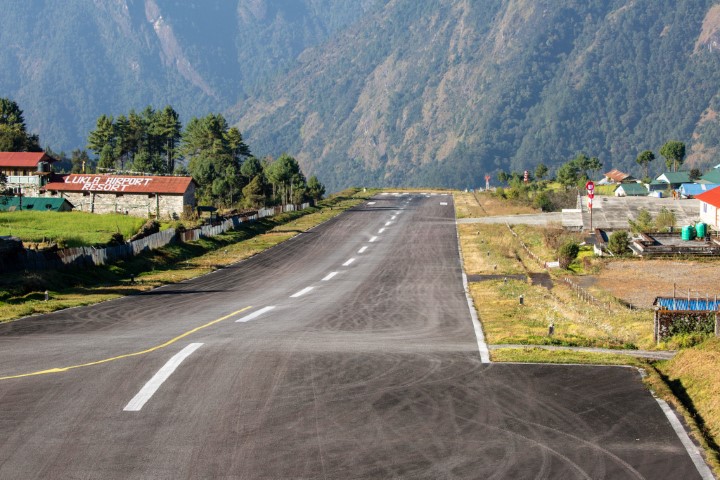
Lukla Airport’s runway and landing procedures are engineered to handle the extreme challenges its Himalayan location poses. While the airport’s short length, steep slope, and high altitude make it technically demanding, strict protocols and specialized pilot training ensure safe operations.
The runway has an 11.7% incline, meaning landings are uphill to help slow the aircraft and takeoffs are downhill to assist acceleration. This slope is critical because it compensates for the short runway length and helps reduce landing speed by about 10 knots.
At 2,845m (9,334ft), the thin air reduces engine power by approximately 30% compared to sea level and aircraft lift, requiring longer takeoff rolls. Pilots must adjust thrust settings and use full flaps for optimal performance.
Aircraft follow a carefully planned descent through the Khumbu Valley, maintaining constant visual contact with the runway; there are no instrument landings here. Pilots use the 12° uphill slope to their advantage, helping slow the plane naturally. They touch down within the first 100 meters, ensuring plenty of room to stop safely.
Pilots use a slightly steeper approach than normal to clear terrain, adjusting speed precisely as too fast risks overshooting and too slow risks stalling. The moment the wheels touch, maximum reverse thrust and braking are applied, stopping the plane efficiently.
Planes face downhill for extra acceleration, with pilots using full power before releasing brakes for a quick lift-off. Optimal flap settings ensure smooth ascent, and within seconds, the aircraft clears the southern cliff, entering safe airspace.
Lukla isn’t unsafe, it is just different than what we are used to seeing and experiencing. With thousands of safe flights yearly, the airport’s reputation for danger is outdated. Proper training and procedures make it as secure as any other mountain airstrip.
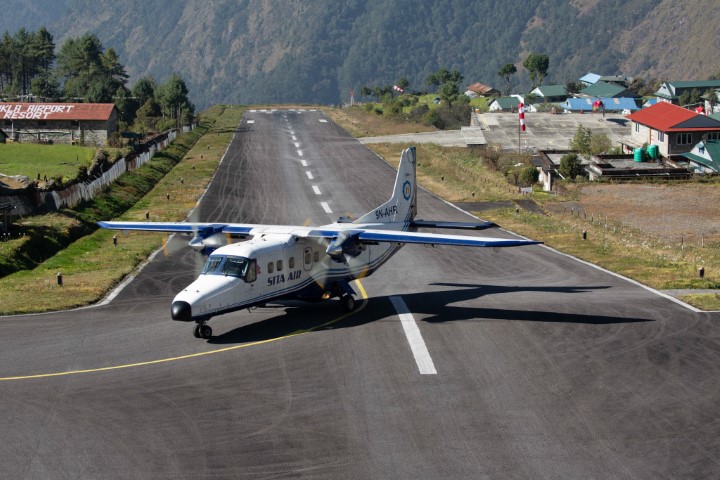
The following reasons also help make the Lukla Airport system stronger:
- Highly trained pilots with specialized certification
- Flights only in clear weather, no risky landings in poor visibility
- The slope and short runway are advantages, not hazards
- Modern safety protocols ensure reliable operations.
Safety Measures for Lukla’s Runway Operations
| Category | Requirements & Protocols |
Aircraft Restrictions |
|
| Weather Minimums |
|
| Pilot Certification |
|
| Runway Maintenance |
|
How Lukla’s Runway Compares to Other Dangerous Airports
| Airport | Runway Length | Slope | Key Challenge |
| Lukla (Nepal) | 527m | 12% | Mountain walls and no go-around |
| Courchevel (France) | 537m | 18.5% | Downhill landing only |
| Toncontín (Honduras) | 2,163m | 0% | City obstacles on approach |
| Madeira (Portugal) | 2,781m | 0% | Ocean cliff and crosswinds |
Landing: A brief but firm touchdown with immediate braking.
Takeoff: Rapid acceleration followed by a steep climb.
Noise: Propeller aircraft are louder than jets.
Views: Unmatched Himalayan scenery during the approach.
Useful Tips for You
- Sit on the left side as it has the best mountain views
- Keep the seatbelt tight until full stop, quick deceleration
- Morning flights have the calmest winds.
Lukla Airport (Tenzing-Hillary Airport) operates under specialized aviation protocols. The airport strictly follows visual flight rules (VFR), meaning all flights must occur during daylight hours when pilots have clear visibility of the treacherous Himalayan terrain.
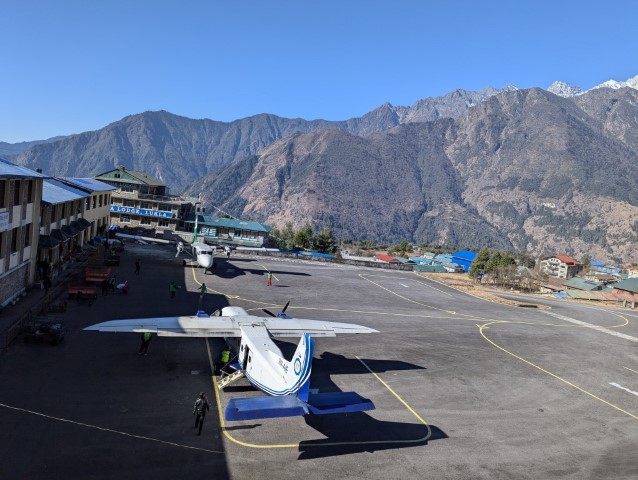
During peak trekking seasons in spring (March-May) and autumn (September-November), the airport handles an impressive 30-50 daily flights, with all operations condensed into a narrow 6:00 AM to 12:00 PM window.
This limited schedule exists because afternoon winds and cloud cover make flying too dangerous. The Civil Aviation Authority of Nepal(CAAN) mandates that no flights can operate if winds exceed 15 knots or visibility drops below 5 km.
Interestingly, while the airport officially closes at noon, the last flights typically depart by 11:30 AM to ensure safe returns to Kathmandu before weather deteriorates.
Only three airlines have been certified by the Nepalese government to operate the challenging Lukla route, each with impeccable safety records in mountain flying.
Tara Air, the most experienced operator, conducts more than half of all Lukla flights and hasn't had a major incident since upgrading its fleet in 2019.
Summit Air and Sita Air complete the remaining flights, with all three airlines using short takeoff and landing (STOL) aircraft specifically engineered for high-altitude operations. The workhorse of the fleet is the 19-seat DHC-6 Twin Otter, renowned for its ability to land in just 400 meters when necessary.
These turboprop planes feature reinforced landing gear, high-lift wing designs and powerful Pratt & Whitney PT6 engines that maintain performance in thin mountain air. For comparison, these same aircraft models are used by NASA for Arctic research missions, demonstrating their rugged reliability.
Securing flights to Lukla requires careful planning due to extreme demand and weather uncertainties. During peak seasons, travelers should book at least 2-3 months in advance, especially if needing specific dates.
The booking system operates on dual pricing; official airline websites show standard rates, while local trekking agencies often secure better deals through bulk contracts.
Every ticket has strict terms: no refunds for weather cancellations (only flight credits), and mandatory reconfirmation 24 hours before departure. Savvy travelers always build in 2 to 3 extra days before their trek starts to accommodate potential delays.
The Kathmandu to Lukla flight is one of the world’s most spectacular short-haul journeys. The 35-minute flight follows a winding path through the Himalayas, with pilots moving through deep valleys just 100 meters wider than the aircraft's wingspan.
Since 2018, an alternate route from Manthali Airport (Ramechhap) has relieved congestion during peak seasons. This 20-minute flight costs slightly less but requires travelers to depart Kathmandu by 2:00 AM to make morning flights.
The Civil Aviation Authority has implemented staggered departure slots at both airports to prevent overcrowding, with exact schedules changing weekly based on weather predictions.
All flights use visual navigation waypoints like the Bhote Koshi River and specific mountain peaks since the route lacks radar coverage for its entire duration.
Kathmandu's Tribhuvan International Airport has a specialized check-in process for Lukla flights. Passengers must arrive 2 hours early for mandatory individual weigh-ins, a digital scale measures each traveler with their baggage to ensure the strict 15kg limit (10kg checked + 5kg cabin) isn't exceeded.
The security screening is surprisingly efficient, though all lithium batteries must be carried onboard. After check-in, passengers board buses for the 10-minute ride to the domestic tarmac where small aircraft await.
Upon landing in Lukla, the experience is starkly different - the single-runway airport has no jet bridges or baggage carousels.
Passengers walk just 50 meters from the plane to the terminal, where bags are manually unloaded. The entire process from landing to exiting takes under 15 minutes, a necessity given the constant flow of aircraft at this high-altitude hub.
Lukla's infamous weight restrictions stem from aircraft performance requirements at high altitude. The 15kg total allowance (including carry-on) is strictly enforced through dual weigh-ins at check-in and boarding. During peak loads, airlines may simply refuse overweight bags entirely.
Seasoned trekkers use compressible duffel bags instead of hard suitcases, which are easier to fit in the aircraft's tight cargo holds. A little-known trick is to wear bulky items like hiking boots and jackets during weigh-in to reduce bag weight. The airlines maintain a left luggage facility in Kathmandu for items not needed on the trek.
Notably, the baggage system has improved significantly since 2020 when automated weight sensors were installed to prevent dangerous overloading
Weather causes 15-20% of Lukla flights to cancel annually, with June-August monsoon months seeing 40% cancellation rates. When flights cancel, airlines automatically rebook passengers on the next available flight, usually the following morning.
For those who can't wait, three alternatives exist: helicopter charters, the scenic 7-day Jiri trek, or an 8-hour jeep ride plus 3-day trek from Phaplu.
Travel insurance becomes crucial here, only specialized adventure policies cover these alternate arrangements. The airport has recently installed a real-time weather dashboard in the terminal showing wind speeds at different valley points, helping travelers anticipate potential delays.
Despite its remote location, Lukla Airport offers basic but functional facilities. The single-terminal building has a heated waiting area (a recent upgrade), free WiFi (spotty but usable), and a decent cafeteria serving Sherpa stew and milk tea. Just outside, porter services are available for immediate hire.
The airport maintains a 24-hour medical post staffed by a nurse for altitude-related issues. For those needing last-minute supplies, several shops within 200 meters sell everything from crampons to SIM cards.
A little-known gem is the airport viewpoint behind the control tower offering unparalleled photos of landing aircraft with Everest in the background on clear days.
Successful Lukla travel requires meticulous preparation. Beyond packing light, travelers should: carry printed copies of flight confirmations (digital might not suffice), have small Nepalese bills for airport fees, and pre-download maps since connectivity is unreliable.
The left side window seats (A for Kathmandu-Lukla, B for return) offer the best mountain views. Dress practically as planes are unheated and morning flights can be bitterly cold at altitude.
Most importantly, maintain flexibility - even perfect weather can delay flights if cloud cover obscures any part of the visual flight path. Seasoned travelers treat the Lukla flight as the first adventure of their Everest trek rather than mere transportation.
Lukla Airport's operations are entirely at the mercy of Himalayan weather patterns, which create some of the most unpredictable flying conditions in commercial aviation.

Located at 2,845 meters (9,334 feet) in a steep valley, the airport experiences microclimate weather that can differ dramatically from nearby Kathmandu.
The collision of moisture-laden monsoon winds with towering Himalayan peaks creates rapidly changing conditions where visibility can drop from 10km to zero in under 15 minutes.
Pilots report encountering four distinct weather systems during the 35-minute flight from Kathmandu, including:
- Sudden valley fog that forms without warning
- Powerful downdrafts along the Bhote Koshi River canyon
- Wind shear at the runway threshold reaching 25 knots
- Afternoon cumulus clouds that obscure the visual approach path
The best months for reliable flights are during the pre-monsoon (March-May) and post-monsoon (September-November) periods when:
- Visibility averages 8-10km in the mornings
- Wind speeds remain below 10 knots until noon
- Cloud bases stay above 3,000 meters until afternoon
However, each season brings unique challenges:
- Morning temperatures below freezing require aircraft de-icing
- Snow accumulation closes runway 2-3 days per month on average
- Crystal-clear skies but extreme cold affects engine performance
- 70% of afternoon flights get canceled
- Cloud ceilings often drop below mountain tops
- Landslides sometimes block the alternate ground route
The air traffic control team at Lukla uses a multi-layered weather monitoring system:
- Automated Weather Stations at 5 points along the flight path
- Pilot Reports from preceding flights
- Visual Observations from the control tower and valley lookouts
- Satellite Imagery is updated every 30 minutes.
A flight will be immediately canceled if any of these conditions occur:
- Clouds below 1,500 meters on the approach path
- Crosswinds exceeding 12 knots
- Visibility under 5km at any reporting point
- Precipitation at Lukla or en route.
Weather delays create a cascade effect for travelers:
- Re-booking queues can stretch 3-4 days during peak seasons
- Accommodation shortages occur in both Kathmandu and Lukla
- Trek itineraries may need complete reorganization.
Smart travelers prepare by:
- Building 3 extra days into itineraries
- Packing essentials in carry-on (meds, documents)
- Registering with airlines for SMS weather alerts
Note: If the weather looks favorable with clear skies, the flights are operated till 4 PM for Lukla Flights.
Recent upgrades have reduced weather-related incidents even further.
- Doppler radar installations along the flight corridor
- Automated ceiling/visibility sensors at the runway
- Real-time wind mapping displays in cockpits
- Improved de-icing systems for winter operations
The next-generation weather system (planned for 2025) will feature:
- AI-powered forecasting with 90-minute predictions
- LIDAR wind detection for approach path
- Pilot weather tablets with live 3D terrain mapping
This shows how advanced forecasting and strict safety protocols mitigate (but can't eliminate) weather risks at the world's most challenging airport.
Securing your Lukla flight requires some planning due to extreme demand and unpredictable Himalayan weather. During peak trekking seasons (March-May and September-November), you’ll need to book your flights 3-4 months in advance through reliable trekking agencies or directly with airlines like Tara Air or Summit Air.
Check for exact baggage allowance (typically 10kg checked + 5kg carry-on), flexible rebooking policy for weather cancellations, and if possible, specific seat assignments (left side windows offer the best Everest views during approach) when you get your booking confirmation.
- 90-60 days before departure: Purchase comprehensive travel insurance that specifically covers helicopter evacuation (minimum $100,000 coverage) and trip interruptions due to weather.
- 30 days out: Triple-confirm all flight details and understand that you'll need to reconfirm 72 hours before departure, as airlines frequently adjust schedules.
- 14-7 days out: Begin daily monitoring of Lukla weather forecasts through specialized aviation sites.
The 15kg total weight restriction (10kg checked + 5kg carry-on) needs strategic packing. Veteran trekkers swear by these battle-tested techniques:
- Wear your heaviest items during check-in. This means your trekking boots, down jacket, fleece pants and even stuffing pockets with energy bars.
- Use ultra-compressible packing cubes from brands like Eagle Creek to maximize every cubic centimeter of your duffel space.
- Coordinate with trekking partners to share group gear like first aid kits, water filters, and charging equipment.
- Waterproof document folder containing printed flight confirmations, passport copies, insurance documents, and emergency contacts.
- Comprehensive medical kit including altitude medication, blister treatments, and rehydration salts.
- High-calorie, compact snacks like nuts, chocolate, and energy gels to survive potential 24-plus-hour delays.
- 20,000mAh+ power bank as Lukla’s electricity is unreliable and charges an hourly fee for electricity usage.
Kathmandu's Tribhuvan International Airport operates under unique procedures for Lukla-bound passengers that first-timers often find overwhelming:
- Be at the airport at least 60 minutes earlier for morning flights. The check-in counters for Lukla flights typically open at 5:00 AM. Flights are primarily scheduled for early morning hours to take advantage of calmer weather conditions and better visibility.
- Dress in smart layers as the unheated domestic terminal and aircraft cabins can be freezing at dawn, but you might want to shed layers after landing in Lukla's milder daytime temperatures.
- Carry 5,000 to 10,000 Nepali rupees in small bills for last-minute purchases like bottled water, snacks, and potential excess baggage fees.
You'll step on the scale with all your carry-on items, including your daypack, camera, and even the jacket you're wearing. Then your duffel bag will be inspected. Airlines require soft-sided, compressible duffels (no hard suitcases) that conform to aircraft cargo holds.
If over limit, staff can remove items until you comply, so have a contingency plan for storing non-essentials in Kathmandu.
Flight cancellations are virtually guaranteed. So, smart trekkers prepare for such scenarios.
- Schedule minimum 2 extra nights before and after your trek, but a majority of delayed passengers get out within 48 hours.
- Pre-book flexible Kathmandu accommodations near the airport, like the Hotel Himalaya or Airport Hote,l for quick changes.
- Sprint to the airline desk immediately as rebooking queues form instantly and can mean the difference between flying next morning or waiting 3 days.
- Helicopter options are there. Shared charters cost approximately $500-800 per person so have cash ready as there might be times when your credit cards fail.
- The classic Jiri trek approach takes 7 days but avoids flying entirely. Research this backup route in advance, just in case you need it.
Lukla’s elevation (2,845m/9,334ft) shocks many travelers who fly directly from Kathmandu's 1,400m. Proper preparation prevents ruined treks.
- Begin aggressive hydration 3 days pre-flight. Aim for 4- 5L/day with electrolyte supplements.
- Complete alcohol avoidance 48 hours before flying, as dehydration dramatically worsens altitude symptoms.
- Many doctors recommend starting this altitude medication 24 hours before flying to Lukla. Consult a travel medicine specialist.
Purchase an Ncell SIM card at Kathmandu airport arrivals. The NTC SIMs sold in town rarely work in Khumbu. Download offline mapping (Maps.me with Everest region maps). GPS works without service. Also, establish check-in protocols with your family.
Carry about 3 high-capacity power banks. Lodges charge exorbitant rates for electricity. Solar chargers like Anker PowerPort Solar work well during clear days. Conserve phone batteries by using airplane mode and only enabling connectivity at scheduled times.
Tip: The Everest Link WiFi system offers the most reliable connection, so purchase login codes (usually Rs. 1,000 for 100MB) in Lukla before ascending higher where options disappear.
Weather disruptions at Lukla Airport are common, but smart trekkers know how to adapt. With the right backup plans, you can keep your Everest Base Camp trek on track even when flights get canceled.
Below, we break down the most reliable alternative routes to Lukla, including helicopter transfers, ground options, and emergency strategies.
When flights to Lukla are grounded, helicopter charters offer the quickest solution. These shared helicopter rides cost 500–800 per person and take just 45-60 minutes from Kathmandu. Unlike fixed-wing planes, helicopters can fly in slightly worse weather, needing only 4,900 feet of visibility to operate.
However, they still follow strict weight limits (10 to 15kg per person) and require cash payments since ATMs in Lukla are unreliable. For last-minute bookings, trusted operators like Air Dynasty and Fishtail Air are the safest choices.
Before Lukla Airport existed, all trekkers took the Jiri route, a scenic but challenging 7 to 9 day hike. Starting with a 6 to 8 hour drive from Kathmandu, this trail covers 90km with 3,500m of elevation gain before reaching Lukla.
The slower ascent helps with acclimatization, and the quiet trails pass through authentic Sherpa villages. While it adds time to your trip, this historic path is perfect for trekkers who want to avoid flights entirely and experience the Himalayas at a traditional pace.
For those who want a middle-ground alternative, the Phaplu or Salleri route is a great choice. You can reach Phaplu by a 1-hour flight or a 10-hour drive from Kathmandu. From there, it’s a 4–5 day trek (50km) to Lukla, with less crowding than the main trail.
Since Phaplu sits at a lower altitude than Lukla, flights there cancel less often, making it a smart backup for avoiding long delays.
During March to May and September to November, many Lukla flights depart from Manthali Airport instead of Kathmandu. The 4 to 5 hour drive from Kathmandu is worth it, flights from Manthali take just 20 minutes and have a higher on-time rate due to less air traffic.
If you’re booking last-minute in peak season, this is often the most reliable way to reach Lukla.
If your flight gets canceled, act fast to secure alternatives
- Get rebooked on the next available flight (lines form quickly).
- Check for helicopter seats; group discounts can lower costs.
- Consider ground transport to Jiri or Phaplu if delays last multiple days.
- Adjust your trekking schedule to make up for lost time.
Lukla Airport is more than just a gateway to Mount Everest, it’s a lifeline for Sherpa communities and a symbol of Himalayan resilience. Since its construction in 1964, the airport has transformed the Khumbu region, connecting remote villages to the world while preserving centuries-old traditions.
The airport’s presence has made the Everest region accessible, bringing trekkers face-to-face with Sherpa traditions. Villages like Namche Bazaar and Tengboche thrive because of Lukla’s connectivity, allowing visitors to experience:
- Ancient Buddhist monasteries with vibrant prayer ceremonies
- Traditional Sherpa festivals like Mani Rimdu
- Homestays and tea houses run by local families
Without Lukla, these cultural exchanges would require weeks of trekking, limiting outside interaction. Now, Sherpa artisans, guides, and lodge owners can share their heritage while benefiting from sustainable tourism.
Lukla Airport fuels the local economy by enabling tourism jobs (guides, porters, lodge staff), trade of supplies (food, gear, construction materials), emergency access for medical evacuations.
Before the airport, goods arrived via multi-day mule caravans. Today, fresh produced, solar panels, and even schoolbooks reach Lukla in 30-minute flights, improving living standards across the region.
Renamed Tenzing-Hillary Airport in 2008, the airport pays tribute to Sir Edmund Hillary and Tenzing Norgay, the first climbers to summit Everest. Hillary helped build Lukla to support Sherpa communities, proving the airport was never just about tourism; it was about empowering Himalayan people.
Today, trekkers begin their journeys where legends once did, walking the same trails that shaped Everest’s golden age of exploration.
Lukla Airport isn’t just a transit point to the inner Everest region, it’s a bridge between cultures. It supports Sherpa livelihoods, preserves Himalayan heritage, and keeps the spirit of exploration alive. For trekkers, passing through Lukla is the first step into the area of the highest mountain of the world.
References
Bureau of Aircraft Accidents. (2025). Accident Archives. Bureau of Aircraft Accidents. https://www.baaa-acro.com/crash-archives?field_crash_city_target_id=Lukla-Tenzing-Hillary%20(22447)
Civil Aviation Authority of Nepal. (2024). CAAN Report 2024. CAAN. https://caanepal.gov.np/storage/app/uploads/public/677/4da/0e7/6774da0e72bfc287016657.pdf
Trek Me Nepal Archives
Check out recent travel trends and news by Trek me Nepal
More Reasons Why Travellers Trust Us
Bipin Thapa
Operation Manager | Official Trekking Guide
Anyone who has trekked before knows trekking requires planning, and a deep understanding of the land. That is where Bipin Thapa Magar comes in. As the Operations Manager at Trek Me Nepal, he is the ba... Read More